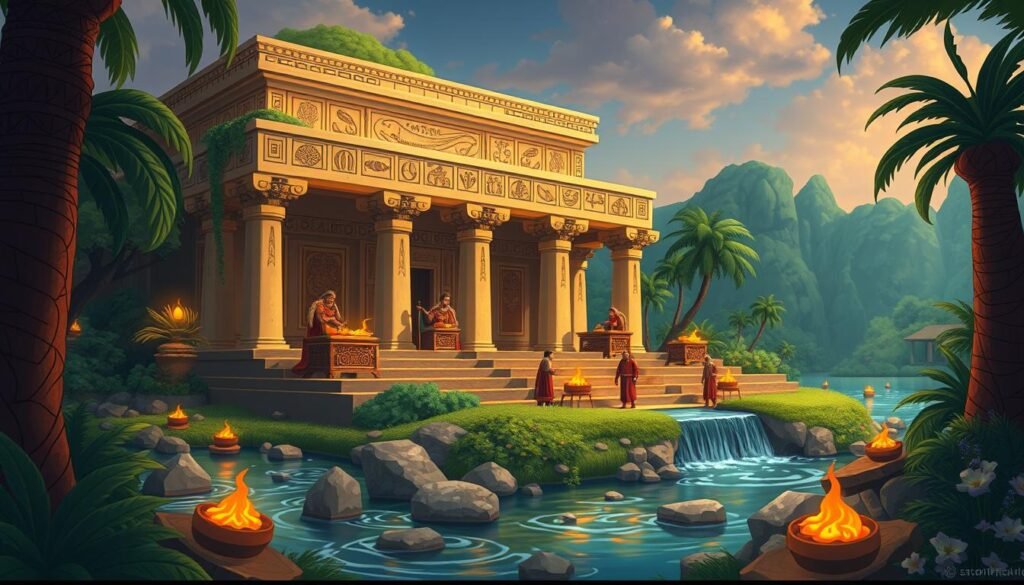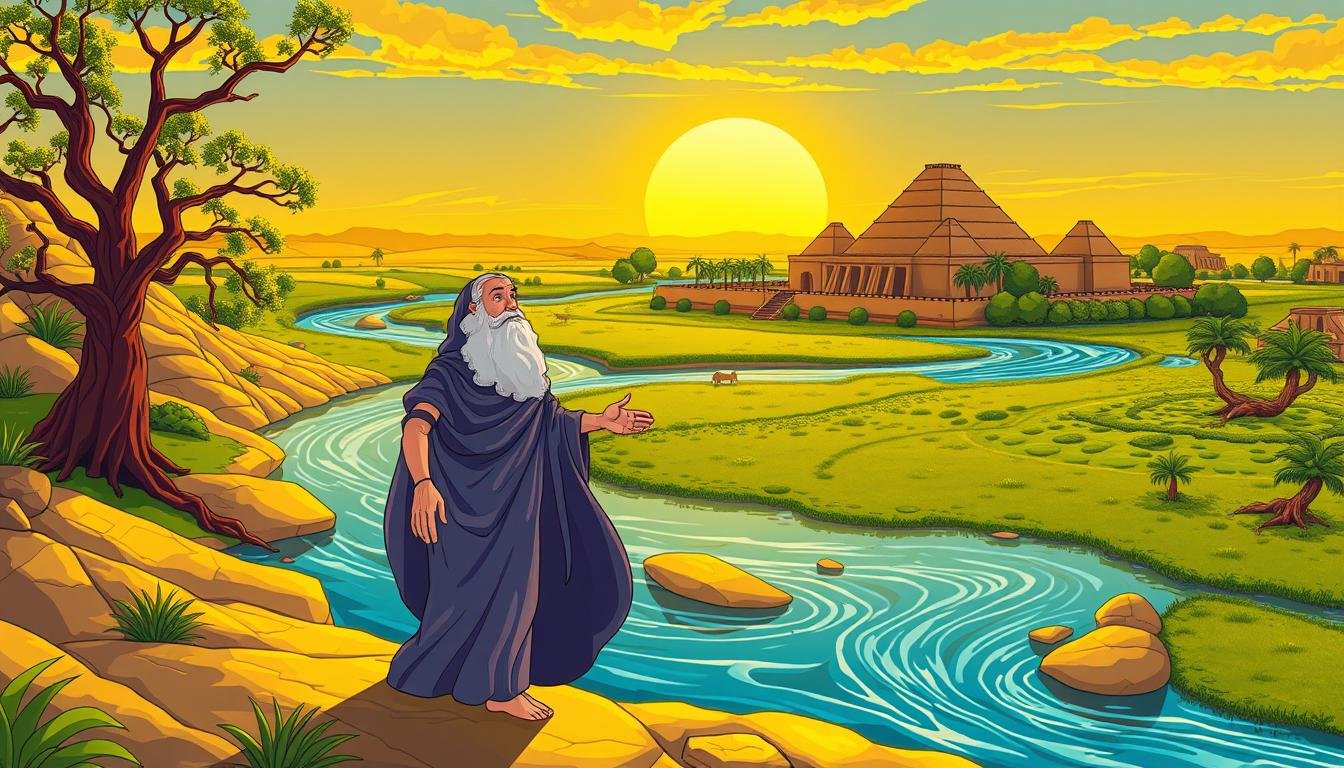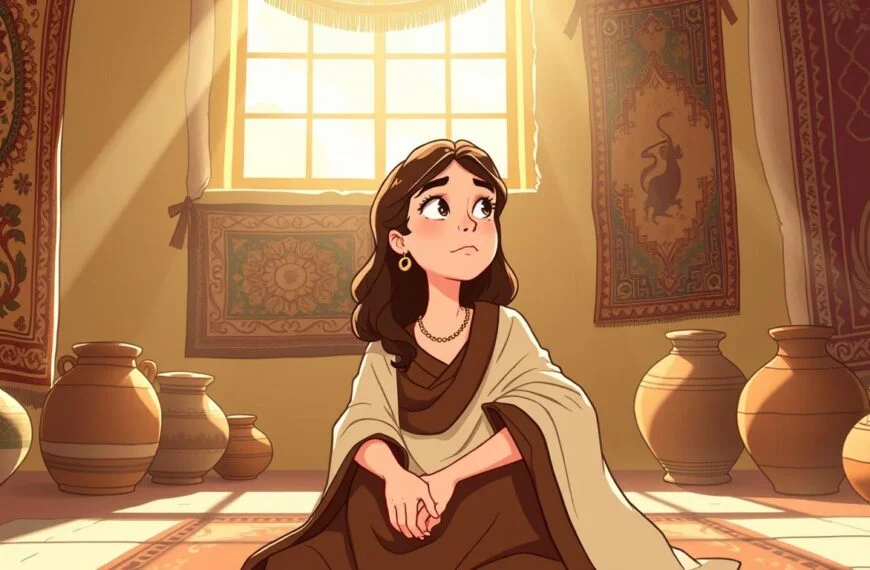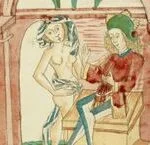What if Enki, the Sumerian god of water, creation, and wisdom, is more connected to the Bible than we think? As we look into the Bible and ancient texts, Enki shows up as more than just a Mesopotamian god. He might change how we see gods in religious stories.
Enki is famous for ruling over the Abzu, the freshwater sea under the earth. His story has lasted for thousands of years, influencing many religious beliefs. This article will explore the interesting links between Enki and biblical characters like Yahweh. We’ll talk about the shared symbols that go beyond cultural differences.
Understanding Enki: The Sumerian God
Enki is a key figure in Sumerian myths. He is a god of water, wisdom, and creation. His name means “Lord of the Earth.”
He is often shown with water, showing his importance in farming and community life. This shows how Enki helped Sumerian society grow and heal.
Enki is smart and clever, helping people in myths. In the story of Atrahasis, he helps build an ark for a big flood. This shows he cares for humans, unlike Enlil who wanted to harm them.
Enki and his wife, Ninhursag, are also important in myths. Their daughter, Ninsar, stands for life and birth. This shows Enki’s role in growth and care for people.
Enki’s Role in Ancient Mesopotamian Religion
Enki was a key figure in ancient Mesopotamia. He was known for his wisdom and control over water. He was seen as the god of creation.
His influence was felt in many parts of life. This was because ancient Mesopotamia was an agrarian society.
The E-Abzu temple was dedicated to Enki. It was more than a place of worship. It was a center for rituals that honored Enki’s role in water and fertility.
Music was a big part of these ceremonies. Enki was thought to have helped create musical instruments. This added to the festive feel of these gatherings.
Enki’s myths show his importance as a life-giver. He was often called upon in times of need. He was seen as a source of support and healing.
He was also involved in art, crafts, and magic. This shows his wide-ranging influence on the Sumerians. His wisdom, creativity, and nurturing made him very important in ancient Mesopotamian religion.

Who Is Enki In The Bible?
Enki plays a big role in the Bible, much like Yahweh. In Sumerian myths, Enki and Enlil control the Earth. But Enki is special because he’s all about water and wisdom.
Looking into Enki shows us interesting links to biblical characters, like Yahweh. These connections show how ancient Mesopotamia and early biblical stories shared ideas.
Comparative Analysis with Biblical Figures
Enki and Yahweh share some traits, like being creative and caring for people. Sumerian stories say Enki helped create humans, teaching them to be smart and independent.
This is different from Enlil, who wanted to control humans, like in the Garden of Eden story. Enki, on the other hand, helped humans grow and survive, just like Yahweh in the Bible.
Theological Parallels Between Enki and Yahweh
Looking at Enki and Yahweh together shows us interesting similarities. Both are seen as wise and caring in their stories. Enki is often shown as a snake, symbolizing knowledge and healing.
This is different from how snakes are seen in Christianity, as evil. This change shows how these stories and symbols have evolved over time. It shows that ancient cultures shared ideas about gods and humans.
The Mythology of Enki
Enki’s story is key to understanding ancient myths. It shows how he helped create humans. This is seen in the Atrahasis epic.
Enki is seen as a kind god. He wanted to help the younger gods. He made humans to share the work.
Creation Myths Involving Enki
Enki is a big name in many myths. The Atrahasis epic tells how he made humans. This was to help the younger gods.
Humans were made from a divine being. This shows a deep bond between gods and humans. It also shows Enki’s values of care and wisdom.
Enki’s Influence on Human Creation
Enki’s role goes beyond just creating humans. His story shows the bond between gods and humans. It’s not just about serving.
Enki’s actions show compassion. This helps us understand the relationship between gods and humans. It shows how they influence each other.
Enki’s Symbolism and Iconography
Enki’s symbols and pictures are key to knowing his importance in ancient Mesopotamia. He is often shown as a bearded man with a horned cap. This shows he is a god of great power.
He is linked to water, which means life and growth. This shows he is the god of fresh water and wisdom.
Trees in his pictures mean both male and female, showing his wide influence. Fish and goat pictures are also common. They talk about fertility and making new life, important to Sumerians.
Enki was connected to the city of Eridu and its temple, E-abzu. This shows he was a very important god. His link to the city and temple adds to his legend.
The Worship of Enki: Temples and Rituals
The main temple for Enki was called E-abzu. It was in Eridu, a key place for his rituals. This temple, shaped like a ziggurat, was near water. It was a key spot for worship, even in the Persian period.
Worship of Enki included big community gatherings and feasts. Archaeologists found evidence of ceremonies focused on water and purity. These ceremonies were important for blessings and safety.

Rituals for Enki helped keep the community safe and prosperous. They were key for good crops and healthy animals. The temples were also where priests studied the stars, showing how science and religion were connected in Sumerian culture.
Enki was very important in the Sumerian world. He was seen as the “Grandiloquent lord of heaven and earth” and the father of the Anuna gods. His titles show how much he was respected for keeping the community safe and prosperous.
Believers thought Enki could stop bad floods and droughts with the right rituals. This shows how much they relied on him for a good environment.
In short, Enki’s worship and the rituals in his temples were very important. They helped the community stay connected to the divine. This connection was key for their survival and success in a changing world.
Enki’s Connection to Other Deities
Enki is a key figure in Near Eastern mythology. He shares similarities with gods from other cultures. This shows how mythologies are connected and share themes.
Comparison with Other Near Eastern Gods
Enki is like Poseidon and Ptah. They all deal with water and creation. Comparisons show Enki’s role in creating life is shared by many.
Enki is seen differently in different cultures. He’s seen as a creator or a serpent. This shows how myths change over time.
Enki’s children, like Marduk and Nabu, are interesting. They show how power and leadership are passed down. This shows how gods are connected through stories.
Looking into these connections helps us understand ancient worship. Enki’s story has shaped many religions in the ancient world.
Enki’s Legacy in Modern Culture and Literature
Enki’s legacy is big in modern culture. It shows how he still affects stories and books today. He is seen as a symbol of wisdom and kindness. His story touches on today’s big themes about human life.
Books and movies use Enki’s story in new ways. This keeps his tale alive for new fans. It shows how his wisdom and kindness are still important today.
Authors and scholars use Enki’s myths to talk about human problems. Zecharia Sitchin’s books mix ancient stories with today’s stories. This shows how old tales can still talk to us today.
Enki’s story is still talked about in schools and books. People like Graham Cunningham and Benjamin R. Foster help us see his importance. They show how Enki’s wisdom is still relevant today.
To learn more about Enki’s story and its connection to today, check out Mesopotamian Religion: Myths.
FAQ
Who is Enki in the context of ancient texts?
Enki is a key figure in Sumerian myths. He is known as the god of creation, intelligence, water, and fertility. People are interested in him because he might be like some biblical figures.
What are Enki’s main attributes in Sumerian mythology?
Enki is wise, kind, and connected to water and fertility. He has water flowing from his shoulders, showing life. He helps humans with his wisdom and tricks.
How was Enki worshipped in ancient Mesopotamia?
People worshipped Enki at the E-Abzu temple in Eridu. They had ceremonies for water and fertility. These rituals were important for the Sumerian way of life.
What theological parallels exist between Enki and Yahweh?
Enki and Yahweh share some traits. Both are powerful, creative, and kind to humans. Their actions in myths show they have similar qualities.
What creation myths involve Enki?
Enki is central in myths like the Atrahasis epic. He wants to create humans to help the younger gods. This shows his caring side and the bond between gods and humans.
What symbolism is associated with Enki in ancient iconography?
Enki is often shown as a bearded man with water and trees. These symbols mean fertility and creation. They are important in Sumerian culture.
How does Enki compare to other Near Eastern deities?
Enki is like Poseidon and Ptah as a creator and water god. These similarities show common themes in ancient religions.
What is Enki’s legacy in modern culture and literature?
Enki’s story lives on in today’s stories. Themes like wisdom, knowledge, and kindness are still important. His character helps us understand human experiences through ancient myths.

Rockin’ the faith, one verse at a time!
Growing up, the Bible’s stories deeply impacted me. Now, with over 15 years of preaching experience, I blend timeless teachings with modern technology, making them relevant for today’s world.
Bible Hub Verse is my platform to share historical insights and thought-provoking articles, exploring both familiar and uncommon Christian topics. My passion is building a welcoming online space for everyone to learn, grow in their faith, and discover the Bible’s enduring message.
Join the journey!
God bless you.








